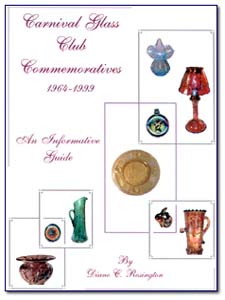Most of which is about my hobby, collecting Carnival Glass.
Enjoy the links to many great antique and carnival glass sites.
To order your copy of my self-published book entitled,
"Carnival Glass Club Commemoratives, An Informative Guide"
by Diane C. Rosington, go to
Commorative Book Order
for instructions and information.
Don't miss out on the history of carnival glass clubs and their souvenirs!
Also featured is information direct from Mr. Frank Fenton of The Fenton Art Glass Company.


Background of Carnival Glass

CARNIVAL GLASS BASICS
Carnival glass was manufactured between 1905 and 1930 by various companies in the United States and abroad. The iridization was achieved by spraying the surface of the glass prior to firing. This produced a very colorful, beautiful product and was extremely affordable for the average family.
Carnival glass is the last hand-shaped glass mass-produced in America. The variety of shapes and colors attest to the glassmaker's skills. When considering a piece of Carnival glass, there are many factors to take under consideration. They are color, manufacturer, shape, finish, availability, and pricing. Much debate has and will take place regarding any or all of these factors and the role it plays in determining a piece's worth.
But in the end, as a collector, I think it can really be summed up like this:
If you see it, like it and can afford it, BUY IT!
A NOTE ABOUT COLOR
Many variations of color exist. Some colors seem to be more readily available from some manufacturers than others.Basic colors are: Marigold, Amethyst/Purple, Blue, Green, Red, White, Teal, Smoke, Ice Green, Ice Blue, Pastel, Clambroth, Aqua Opalescent, Peach Opalescent and many more variations of the above.
A NOTE ABOUT SHAPE
Basic shapes include (but were at the 'whim' of the glassmaker): Bowls (round, oval, sauce, fruit, ice cream and more), tumblers, mugs, decanters, vases, whimseys, plates, pitchers, sugar/creamer/breakfast sets, dresser sets, oil lamps, rose bowls, candlesticks, compotes, nut bowls, spittoons, baskets and many more!
As you can see, Carnival Glass was created to be a versatile, usable product in colors that brighten any home. This was indeed the 'poor man's Tiffany.' Over 70 years later, it is still being sought by collectors from all walks of life, to display, enjoy, cherish.
A NOTE ABOUT DAMAGE
Many antiques show the wear of time, travel and love. Most damage will cause a fluctuation in the prices when compared to a 'perfect' piece. There is an adage that says "Beauty is in the eye of the beholder." So, the question is, if it's damaged, how much does it detract from the beauty?
There are several ways to look at this. You could take the viewpoint that if it's not perfect it's not something that you wish to have in your collection. If you chose this viewpoint, you may just be missing out on having a great piece because of minor damage, which is another way of looking at it. If the piece is missing a major portion, then the answer is probably no...you are not missing out on much. Many collectors cannot afford to have a 'pure' collection. That is why it is important to allow for minor damage when considering a piece and its value. Of course, again, if you are a collector, you approach this from a perspective different from a dealer.
The following are guidelines I was given a few years ago. I hope they will help you when you are deciding whether to buy or pass up a piece of great glass.
All but the the chunk size damage should be priced at about 25% less than the guideline prices. But only you can make the final decision. These are the descriptions you may often encounter.
Scratch - less than a pin head
Pinhead - small head of a straight pin
Chigger bite - same as pinhead
Chip - larger than a pinhead but less that 1/4"
Ding - barely thru the surface
Flake - runs the direction of the glass
Chunk - larger than 1/4"
Pictured below are just a couple of ideas
of what can be done with damaged carnival glass so that it may still be enjoyed.
These were made from an Open Rose/Lustre Rose 10" Marigold Bowl by Imperial.
Display unit by Duncan Displays of Boulder City, Nevada.

Check this out for more information on glass making. Included are pictures, explanations and descriptions of the glass making process.
